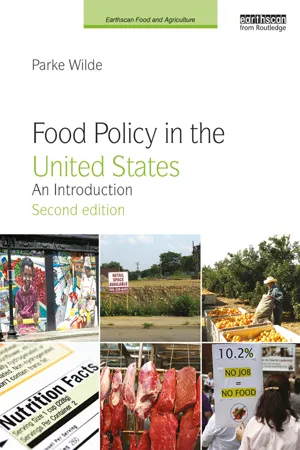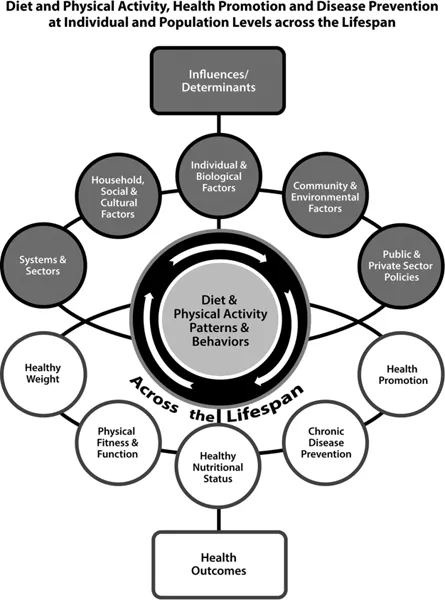![]()
1 Making Food Policy in the United States
1.1 Introduction
This book offers an introduction to food policy in the United States. Food policy encompasses laws, regulations, decisions and actions by governments and other institutions that influence food production, distribution and consumption. While food policy is defined broadly, a food program is a more specific institution that provides or distributes food.
Food policy is intertwined with many of the fundamental economic and social decisions of the day. Will traditional farming in the United States disappear as an economically viable way of life? Can U.S. agriculture contribute to nourishing a growing world population without destroying the environment? What are the causes of low wages for farmworkers? Does globalization help or harm U.S. farmers and food consumers? How can the safety of food be protected without imposing unnecessarily burdensome rules and regulations? What can be done about the epidemic of obesity and chronic disease? How can school lunches be improved? Why do some families go hungry in such a rich country?
U.S. food policy is an important topic for readers in the United States and also in other countries. The United States is the world’s largest exporter for some crops and a leading importer for others. The U.S. government position carries considerable weight in multinational policy decisions about globalization and international trade. Consumers around the world aspire to emulate some aspects of U.S. consumer culture, even as doubts arise about the nutritional merit and environmental sustainability of U.S. food consumption patterns. Some environmental constraints on U.S. agricultural production are local, but others are global. In these respects, the implications of U.S. food policy extend beyond national borders.
This book focuses on national-level food policy in the United States, but there are similarities with policy-making at other levels of government and in other institutions. Federalism refers to the division of authority between the national government and state and local governments. Policy innovations may be first attempted at the state and local level and later adopted at the federal level.
U.S. food policy is absorbing in part because it is dysfunctional. Just as other areas of politics in the United States suffer from partisanship and deep regional and cultural divisions, food policy can become mired down in bitter struggles across stagnant political lines in the sand. On topics ranging from genetically modified organisms (GMOs) to advertising that targets children, it can seem as if no policy actors have either changed their mind or persuaded an opponent in the past generation.
Faced with such challenges, it may be worthwhile to climb down from the ramparts and devote some time to reflection and study. To some extent, this book is a descendant of hefty agricultural policy textbooks such as traditionally were used in departments of agricultural economics in U.S. land-grant universities, but there are important differences. This book tackles both normative questions (about how decisions should be made) and positive questions (about how decisions actually are made) in U.S. food policy. Throughout the book, real-world policy struggles provide the contemporary hook to motivate the reader’s attention to the more specialized details of economic principles, policy analysis, institutional structures and data sources. The study of these more academic topics may pay off even for readers whose primary interest is the policy arena. The hope for this book is that these principles and data sources hold some promise for knocking loose the logjam in policy-making.
Current data sources are particularly influential. Many of this book’s tables and figures provide notes showing how to acquire and interpret the most recent data. In reading tables and figures, do not envision the author standing at a lectern, making an authoritative presentation of static numbers. Instead, envision the author and the reader sitting shoulder to shoulder at a computer screen, following the hyperlinks, poring over the most recently released data and discussing their interpretation.
The book takes a public interest perspective on food and agricultural policy. It assumes that the reader cares about the economic interests of farmers, and also about hired laborers, the environment, food safety, nutrition, consumer welfare and the poor. To introduce several themes and institutions that cut across the subsequent chapters in complex ways, this first chapter:
- connects the public policy perspective of this book to the social ecological framework used in nutrition and public health research (Section 1.2);
- provides an overview of key industries in the food marketing chain (Section 1.3);
- explores the role of both markets and governments in achieving economic and social objectives (Section 1.4);
- studies how interest groups and advocacy coalitions compete to influence food policy (Section 1.5);
- describes the policy-making process, with a focus on the legislative branch of the federal government (Section 1.6);
- describes the policy implementation process, with a focus on the executive branch of the federal government (Section 1.7); and
- describes the use of law in U.S. food policy, with a focus on the judicial branch of the federal government (Section 1.8).
1.2 An Interdisciplinary Approach
Economic and political science perspectives on the food system are especially useful for students of nutrition and public health. The advisory committee for the 2015–2020 Dietary Guidelines for Americans, which is the federal government’s most authoritative official statement on nutrition and health issues (discussed at length in Chapter 8), draws on a social and ecological framework for understanding food consumption and physical activity decisions (Figure 1.1). Similar models are found in many other high-profile nutrition policy documents (Institute of Medicine, 2012). To analyze major nutrition-related health outcomes, this framework goes far beyond immediate causes such as food and beverage intake and physical activity. The framework calls attention to broader systems and sectors, including agriculture (Chapter 2), the food and beverage manufacturing industries (Chapter 5), the retailing and restaurant industries (Chapter 6), marketing and the media (Chapter 9) and socioeconomic factors (Chapter 10). Once nutrition and public health professionals begin to explore these more fundamental influences on food and beverage consumption, they find themselves engaged with the challenging topics in public and private-sector policies addressed in this book.
Figure 1.1 The Dietary Guidelines Advisory Committee’s framework for understanding nutrition and physical activity in their social/ecological context
At first, this engagement can be unnerving. When interacting with patients, professionals in medical fields are rightly proud of their ability to diagnose problems and prescribe an appropriate remedy. It is tempting to adapt this medical patient approach to food policy applications. For example, if expanding food portion sizes contributes to rising rates of obesity, it is tempting to say government agencies should prescribe smaller portion sizes. If nutrient-dense foods cost too much, it is tempting to say government agencies should prescribe a price ceiling for fruits and vegetables. It is disappointing if policy-makers reject such proposals as politically infeasible. It is downright frustrating if policy-makers say with a straight face that a well-intentioned nutrition policy prescription is unwise. Yet, except in special settings such as school meal programs, determining portion sizes may be a decision that people do not want to delegate to their government. A price ceiling for fruits and vegetables may have unintended consequences, such as reducing the incentives to grow fruits and vegetables.
The upper orbits of the social ecological framework bring nutrition policy into contact with many other societal objectives, such as a thriving economy, a healthy environment, poverty alleviation and effective political governance. Powerful policy actors in these outer layers do not—and sometimes should not—behave as if food consumption and physical activity stood alone as the sun at the center of the social ecological solar system. Governments balance food and nutrition concerns against other considerations, just as individuals and families do. As we explore more deeply the normative question of what food policies best serve the public good, it will appear necessary to discern which decisions should be delegated to governments and which decisions should be made by individuals interacting in economic markets. And, as we explore more deeply the positive question of what policies can win political support, it will appear necessary to anticipate how a variety of producer and consumer interests will respond to such proposals. These interdisciplinary explorations are more difficult than simply prescribing the right policy medicine, but ultimately they offer both sharper policy insight and greater potential for political success.
1.3 The Food Marketing Chain
U.S. consumers spent approximately $1.3 trillion on food in 2014 (USDA Economic Research Service, 2017). Food spending has fallen over time as a fraction of all consumer spending, from 17 percent of personal disposable income in 1960 to only 9.7 percent of personal disposable income in 2014. The composition of food spending also has changed. As the U.S. standard of living increased, more women entered the labor force and time became more valuable during the second half of the twentieth century. A larger fraction of food spending went toward food away from home (for example, from restaurants and other food...

